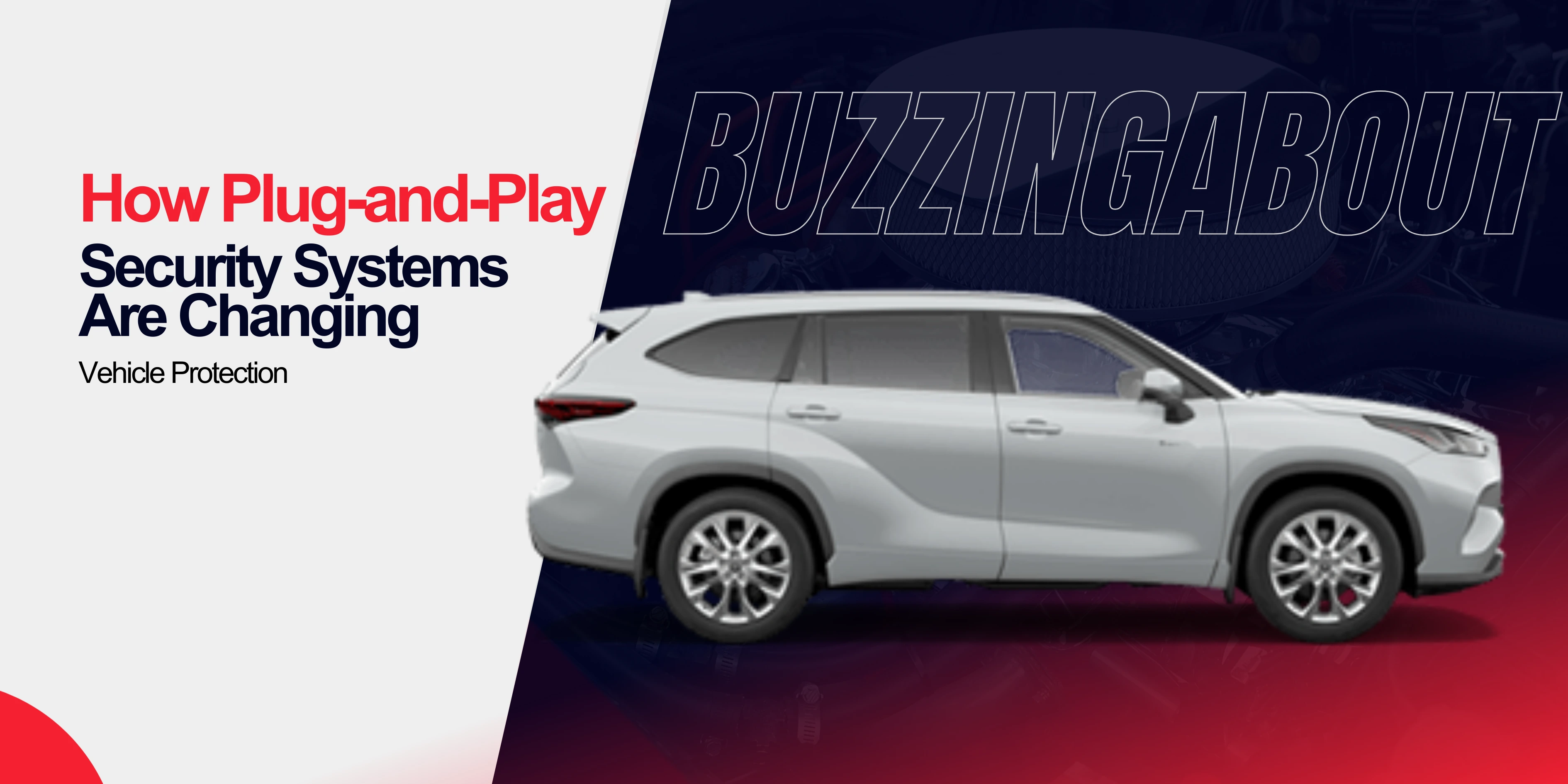How Plug-and-Play Security Systems Are Changing Vehicle Protection

Car theft remains a persistent issue, even as vehicles become smarter and more connected. Traditional alarms and immobilizers have helped, but they often come with downsides: complex wiring, costly installation, and compatibility issues. Today, however, a new approach is gaining momentum plug-and-play vehicle security systems.
One of the most popular options for everyday drivers are plug and play car alarms. These alarms connect directly into your car’s OBD-II port or fuse box and immediately provide protection against forced entry. They’re easy to install, affordable, and act as a strong deterrent for opportunistic thieves who rely on quick, low-resistance targets.
These systems are designed for convenience and accessibility. They connect directly into your car’s built-in electronics, often through the OBD-II port or fuse box, and start working almost immediately. Drivers no longer need to schedule appointments at specialized shops; instead, they can purchase a security device online, plug it in themselves, and enjoy advanced features like alarms, immobilizers, and GPS tracking in minutes.
In this article, we’ll take a detailed look at what plug-and-play security systems are, how they work, their benefits and limitations, and why they’re becoming a game-changer in the fight against car theft.
What Are Plug-and-Play Vehicle Security Systems?
At their core, plug-and-play vehicle security systems are self-installable devices designed to integrate seamlessly with a car’s existing electronics. Unlike traditional alarm systems that require cutting wires and tapping into circuits, these systems simply connect to standardized ports already built into modern vehicles.
Types of Plug-and-Play Security Devices
-
Plug-and-Play Alarms – Trigger loud sirens or alerts when tampering is detected.
-
Plug-and-Play Immobilizers – Prevent the engine from starting without authorization.
-
GPS Trackers – Provide real-time tracking and stolen-vehicle recovery.
-
Hybrid Devices – Combine multiple features such as alarms, immobilization, and tracking in one unit.
Why They’re Popular
-
No need for professional installation.
-
Less risk of damaging a car’s wiring.
-
Quick portability between vehicles.
How Plug-and-Play Security Systems Work
Most plug-and-play systems utilize your car’s OBD-II port, which has been standard in vehicles since 1996. This port provides access to a car’s diagnostics and electronic systems.
Key Features of Operation
-
Alarm Integration
Many devices include motion or shock sensors. If tampering is detected—like someone trying to break a window—an alarm sounds instantly. -
Immobilization
Certain devices allow remote disabling of the engine, either through a fob or smartphone app. Even if thieves bypass the ignition, they can’t drive away. -
GPS Tracking and Alerts
Real-time location tracking ensures that if your vehicle is stolen, you can help law enforcement recover it quickly. -
Smartphone Connectivity
Many systems pair with apps, allowing you to receive instant push notifications, check the status of your car, and even lock/unlock remotely.
Benefits of Plug-and-Play Systems
1. DIY-Friendly Installation
You don’t need technical expertise. Most devices take just a few minutes to install—no cutting, soldering, or professional tools required.
2. Affordability
Traditional car alarms can cost hundreds of dollars in labor alone. Plug-and-play systems typically range between $100–$250, making them accessible to everyday drivers.
3. Portability
If you change cars, you can remove your device and plug it into your new one. This flexibility makes it a one-time investment.
4. Real-Time Monitoring
Smartphone alerts and GPS tracking give you immediate awareness if anything suspicious occurs.
5. Modern Compatibility
These devices are built to integrate with newer vehicles and respond to modern theft techniques, such as relay attacks or OBD hacking.
Effectiveness Against Modern Car Theft
The big question: do plug-and-play systems really work?
Opportunistic Thieves
Yes. For casual or opportunistic thieves, plug-and-play devices act as strong deterrents. Loud alarms, immobilization, and tracking features discourage quick smash-and-grab attempts.
Professional Thieves
While advanced criminals may still bypass certain systems, layered plug-and-play protection makes the process slower and riskier—qualities thieves avoid.
Case in Point
-
GPS trackers increase recovery rates significantly, often helping police locate stolen cars within hours.
-
Immobilizers prevent “drive-away” theft even when a thief has gained entry.
-
Alarm-equipped devices stop most thefts before they escalate.
Compatibility & Limitations
Vehicle Compatibility
-
Works best with vehicles built after 1996 (U.S. standard for OBD-II).
-
Some advanced features may not function fully on older cars.
-
High-end luxury models may require brand-specific solutions.
Limitations
-
Some thieves target the OBD-II port itself, though protective covers are available.
-
Systems may rely on subscription services for GPS tracking, adding ongoing costs.
-
Not all devices are equally reliable—choosing a reputable brand is critical.
Top Plug-and-Play Security Devices
1. Plug-and-Play Alarms
-
Simple to install.
-
Activate sirens upon forced entry.
-
Best for budget-conscious drivers.
2. GPS Trackers
-
Magnetic or OBD-II plug models available.
-
Provide 24/7 location updates.
-
Essential for recovery in case of theft.
3. Immobilizers
-
Prevents the car from starting without the proper fob or app authorization.
-
Highly effective against hot-wiring or key cloning.
4. Hybrid Devices
-
Combine alarms, immobilizers, and GPS tracking.
-
More expensive but comprehensive.
Pros vs. Cons: Plug-and-Play vs. Traditional Systems
Plug-and-Play Pros:
-
Affordable.
-
DIY installation.
-
Portable.
Plug-and-Play Cons:
-
Limited customization compared to professional installs.
-
May not deter elite thieves.
Traditional System Pros:
-
Fully integrated with a car’s electronics.
-
Can include advanced sensors and immobilizers.
Traditional System Cons:
-
Expensive.
-
Requires professional installation.
-
Less flexible if you change vehicles.
How to Maximize Protection
A single plug-and-play device is helpful, but layering multiple defenses creates far greater security.
Suggested Layered Approach
-
Plug-and-Play Alarm for immediate deterrence.
-
GPS Tracker for recovery.
-
Steering Wheel Lock for visible prevention.
-
Catalytic Converter Shield to prevent undercar theft.
By combining these tools, you make your vehicle significantly harder to steal.
Future of Plug-and-Play Security
The future looks bright for plug-and-play systems as cars continue to evolve. Advancements on the horizon include:
-
AI-Driven Threat Detection – Using algorithms to spot suspicious activity before theft happens.
-
Integration with Smart Homes – Linking your car alarm to home security systems.
-
Blockchain Verification – Ensuring secure ownership records tied to car electronics.
Plug-and-play systems aren’t just making vehicle protection easier—they’re redefining it.
Conclusion
Vehicle theft may be evolving, but so are the solutions. Plug-and-play security systems represent a major step forward in accessibility, affordability, and practicality. With features like alarms, immobilizers, and GPS tracking—all installable in minutes—they put powerful protection tools in the hands of everyday drivers.
While they’re not foolproof against every method of theft, their deterrent value and convenience make them an essential addition for anyone serious about protecting their vehicle. Combined with other layers of defense, plug-and-play systems are helping to shape the future of car security.






